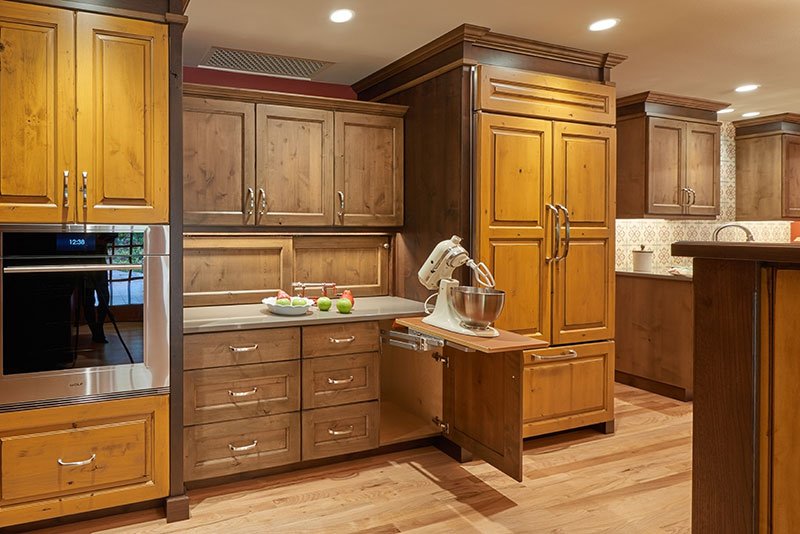Custom Kitchen Design (And the Importance of Listening!)
A recent client of Robin Rigby Fisher Design, Carrie, and her husband built their family home to raise their three daughters with the intention of staying well into retirement. Although the house was custom designed, the kitchen needed help! Carrie is a holiday-host extraordinaire and with three adult daughters and grandchildren as assistants, they needed something better than what they deemed as a “one-butt kitchen”.
What Kitchen Dreams are Made Of
Carrie told me that their kitchen is where her family gathered as she cooked, where the grandkids did their homework when visiting, and where her husband sat with his morning coffee. They desired a homey space that reflected the warmth and love of the people important in their lives.
In listening intently to the clients’ desires for the space, we were able to hone in on their personal style and needs for the new kitchen.
Carrie had interviewed a handful of designers before she came to me, and none of them seemed like the right fit. As a designer, the first step is to listen very carefully, ask lots of questions, and reflect back what you are hearing! Because the client felt seen and heard with us, they were comfortable moving forward on this project.
“I didn’t feel like [other designers] were listening to me. Robin was just a breath of fresh air. She asked what did I want? She wanted to know what I wanted and why. She asked ‘how are you going to use the space?’ I just felt like she really got me. It was like working with a friend.”
The Process: Flow and Customization
To create a kitchen that flows with the entire house, time was spent reviewing the existing floor plan and how each room is used. As I toured the existing space, it was easy to identify the homeowners’ style based on the art and collector’s items in the home. The material and design inspiration came from Carrie’s extensive American folk-art collection.
We requested that Carrie create an inventory list and designated a space for everything. Carrie bakes, makes candy and cooks, and her equipment list is extensive. We decided to customize every cabinet so that each item she owns has its own “place.”
One of the other ways we were able to make the client feel at ease was to be consistently compassionate, communicative and calm!
Of the experience, Carrie said, “Having someone who was really listening, who was compassionate, who helped us through any stumbling blocks, and she was always very calm, it really made a difference in the experience, because it’s stressful! … But, Robin got back to the contractor rapidly all the time. And she always returned my calls quickly too.”
The process took about 5 months to complete, and the couple lived in the home using a makeshift kitchen set up in their garage during construction.
The Details: Customizations in the Home
Creating custom elements for the client, especially the kitchen, is another great way to make them feel like the star of the show!
Carrie is a leftie, and has lived her whole life in a right-handed world. So, when it came time to redo her kitchen, I worked to make sure that everything flowed for a left-handed person. The mixer pulls out on the left side of the counter, the accessories are on the left, etc. It is a kitchen made just for Carrie!
On both ends of the island are two beautiful display cases that boast her salt and pepper shaker collection. Many of them were passed down through generations, and are quite precious. I designed cabinets to accentuate them with gorgeous lighting while keeping them safe.
As the designer, it is very important to us that the clients’ home reflects them and the way they live. I don’t believe in designing for trends and enjoy creating a collaborative design environment with my clients. For example, Carrie didn’t love the cabinet hardware we originally selected, in the end, she found hardware that just sparkled and was just perfect!
Involving the client allows them to feel like they are part of the journey. This means that the final product, though designed by someone else, will feel to the client like it is 100% theirs.
“I loved being able to be involved,” Carrie said, “And there was as much of that or as little of that as I felt comfortable with. It really was like working with a friend. I forgot that I hired her!”
The pièce de résistance in this kitchen design was the tin soffit above the island. Carrie entered the project knowing that she wanted a tin ceiling, but didn’t know how to work it in, and didn’t want it to overwhelm the space. We created the elegant soffit, and lit it with warm uplighting to really highlight the feature. The tin ceiling was a bit of a challenge for the contractor, but with his attention to details and designing it together, the ceiling turned out incredibly well.
Living in a Home That’s Been Renovated
As the designer, it’s so important to check back with clients after the work and hear their feedback once they’ve been living in the space for a while. Ask them what is working well and what they would do differently later. It’s important to know how the space is working in their real lives! This also gives you valuable information as you grow as a designer.
Thankfully, Carrie was very happy with the results and shared that it made her more confident as a cook.
She fondly described how her family was all able to pitch in during the holidays, and how the flow was tremendously improved. Now it’s a kitchen for many butts! Her grandkids are able to sit at the bar and chat with her as she cooks, and they can seamlessly host 35 people for Thanksgiving, then turn around and make hundreds of cookies in the two ovens a week or so later.
A change in space isn’t just about tearing down walls or picking a trending paint color. It can be transformative for how a family lives and interacts together. Helping clients to realize their dreams for the space starts and ends with an expert designer!





